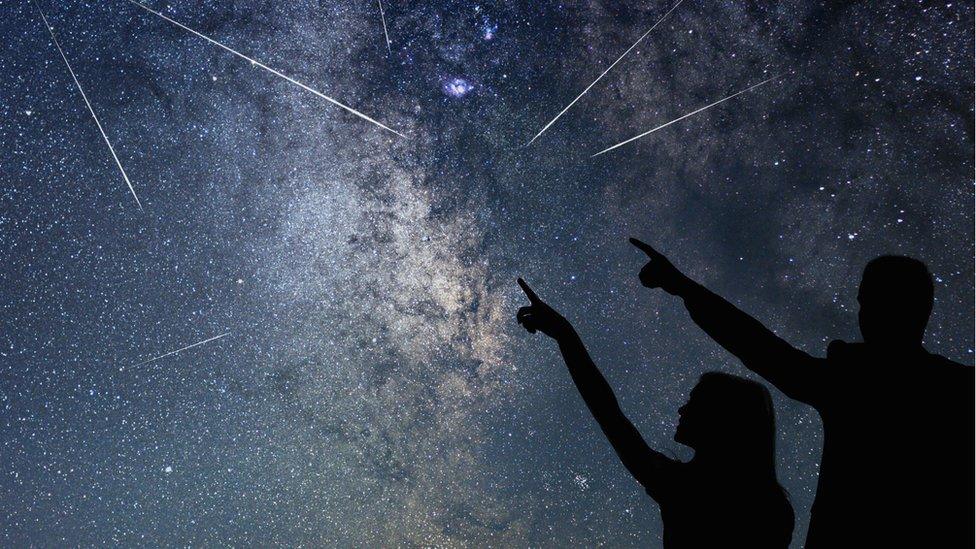December stargazing: what to look out for
- Published
- comments

'Tis the season to be stargazing!
December's night sky promises to be bright and full of as many twinkling lights as Santa's grotto!
Astronomer, Emma Alexander has given Newsround some tips on how to make the most of these celestial delights.
So, set your alarm, wrap up warm, grab your flask of hot chocolate, and head out under the stars with an adult that your trust.
Here's your stargazing guide for December!
Venus shines brightest - 7 December
Venus is the hottest planet in the solar system
If you look up at the night sky this month you'll be able to see what looks like a very bright star - but it's actually Venus.
The planet is the third-brightest object in the sky after the Sun and Moon, which is why it's often called the Morning Star or Evening Star, depending on when it's visible.
On Tuesday 7 December, Venus was at its brightest. It was so bright that it outshone the brightest star in the sky, Sirius, 20 times over.
But don't worry if you missed it!
"Venus is definitely brightest at the moment and will become a little less bright over the month, but from night to night it won't be a noticeable change," Emma Alexander told Newsround.
As long as there's a clear sky, you should be able to spot Venus in the south west, even without a telescope or binoculars!
Expert astronomer Emma says: "It's also worth looking out for Saturn and Jupiter lining up with Venus, and the crescent Moon for the next few days."
Comet Leonard - 12 December
The newly discovered Comet Leonard is due to make an appearance in our skies this month.
It's the first time in 70,000 years that the bright green ice-ball has passed by the Earth.
So, grab your binoculars and prepare for an early start because the best time to spot it is early in the morning on December 10.
Remember to keep away from artificial lights like those in cities or street lamps when looking for this comet.
The darker the skies - the better!
This image of Comet Leonard was captured by the UK's Bayfordbury Observatory in late November
And Emma says this comet is fairly unpredictable...
"[Comet Leonard's] position in the sky changes every night and you'll need to look up where it'll be."
But all of this sounds like too much of a challenge, astronomers think sky watchers might be able to see it without needing binoculars when it passes closest to the Earth on 12 December.
The Geminid meteor shower - 14 December
What is the Geminid Meteor Shower?
One of the most dazzling meteor showers of the year is lighting up the sky this month.
The Geminids are the "strongest meteor shower of the year," according to Nasa.
Meteors are small space rocks - ranging from the size of a grain of sand to a pea - that enter the Earth's atmosphere and burn up, producing a bright streak of light.
The shower is due to peak in the early morning of 14 December.
A view of the Gemenid meteor shower last December in the Sichuan Province, China
"No telescopes or binoculars are needed," Emma says, "If you're lucky, you might be able to see up to 1 meteor per minute."
That's a lot of meteors!
If you want to enjoy the shower, Emma's advice is to "wrap up warm, lie back, and watch the skies!"
Winter solstice - 21 December
It's tradition for thousands of people to meet at Stonehenge every year on the Winter solstice
Monday 21 December marks the Winter solstice across the northern hemisphere.
The date is the 24-hour period with the fewest hours of daylight in the year, which is why it is known as the shortest day and longest night.
Emma says she's particularly excited to take advantage of a long, clear, dark night to spot her favourite constellation - Orion.
"It's probably my favourite constellation that we can see in the winter skies!"
Orion is one of the most recognisable constellations in the night's sky
When stars are grouped together and identified as a pattern, we call that pattern a constellation.
In the past, recognising constellations and stars was vital for people navigating at night.
Orion is one of the most famous constellations in the world, named after a famous hunter from Greek mythology.
"You can try to spot the three stars in a row which make up his belt, and the 'sword' which hangs down from it."
"Part of the sword may look a little fuzzy — that's the Orion Nebula, and it's a place where new stars are being born."
Do be sure to leave us a comment and let us know if you are planning to go stargazing this December and if so, tell us which stars you spotted?
- Published4 October 2019
- Published1 May 2020
- Published7 April 2021
